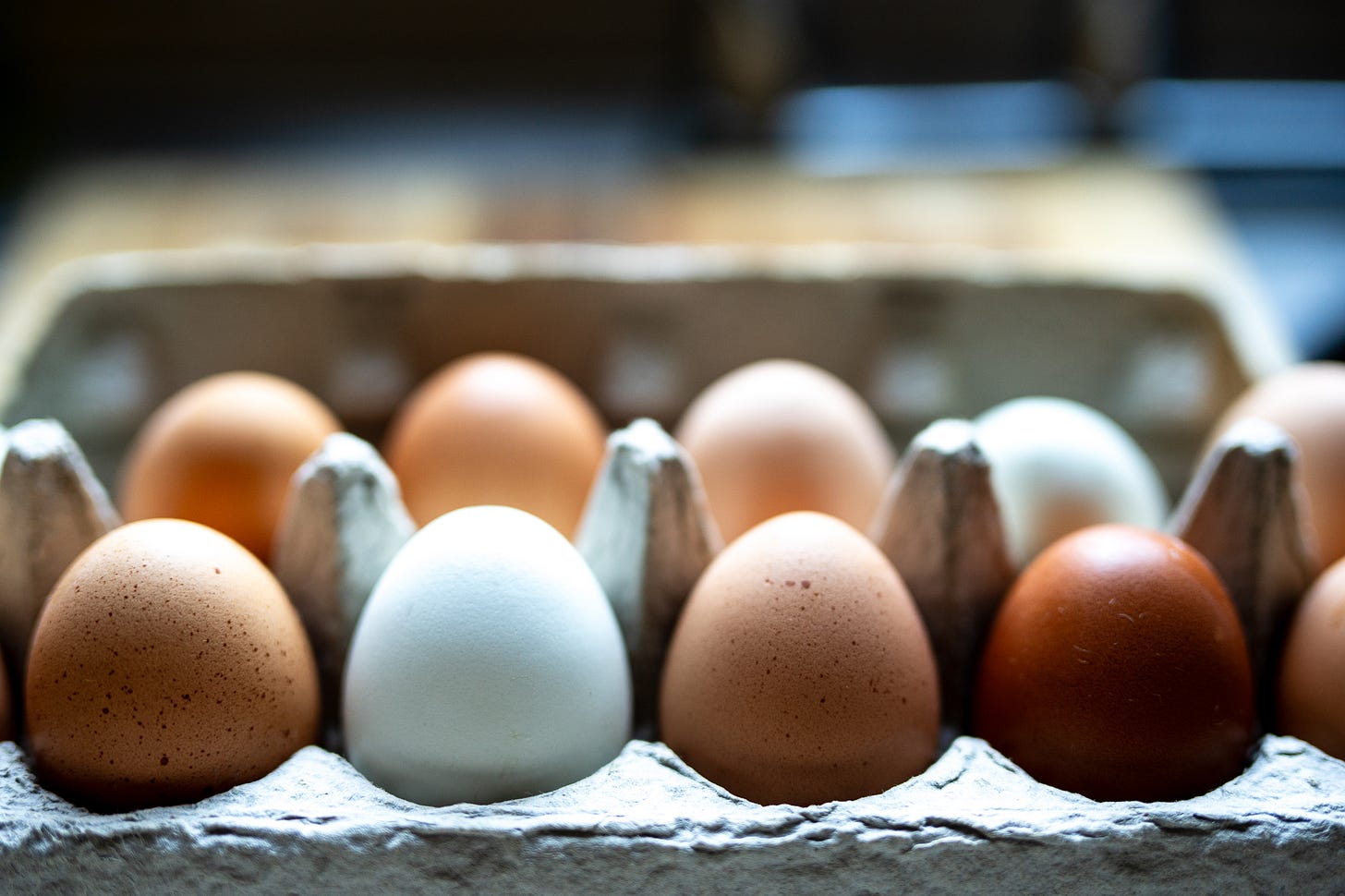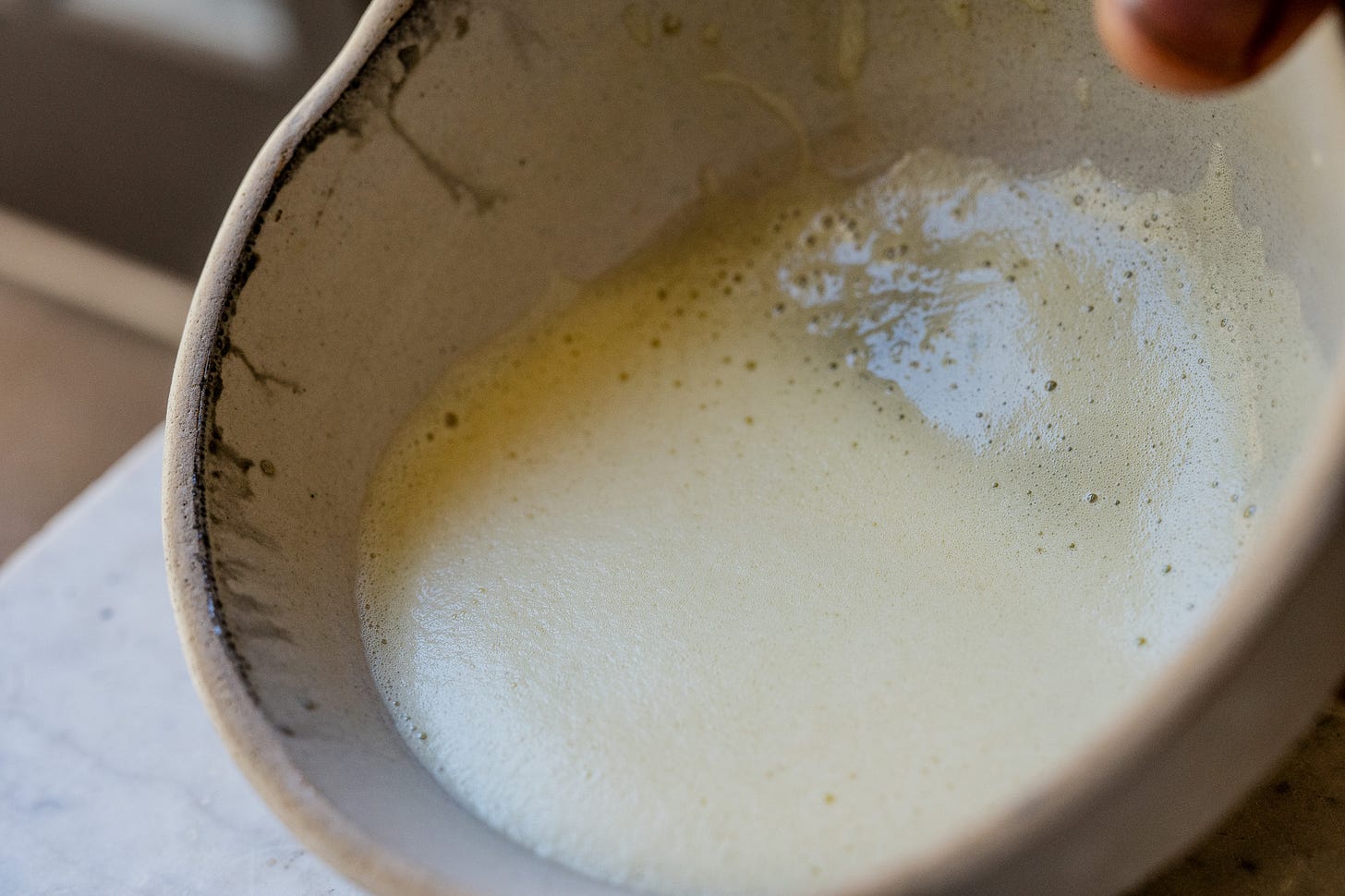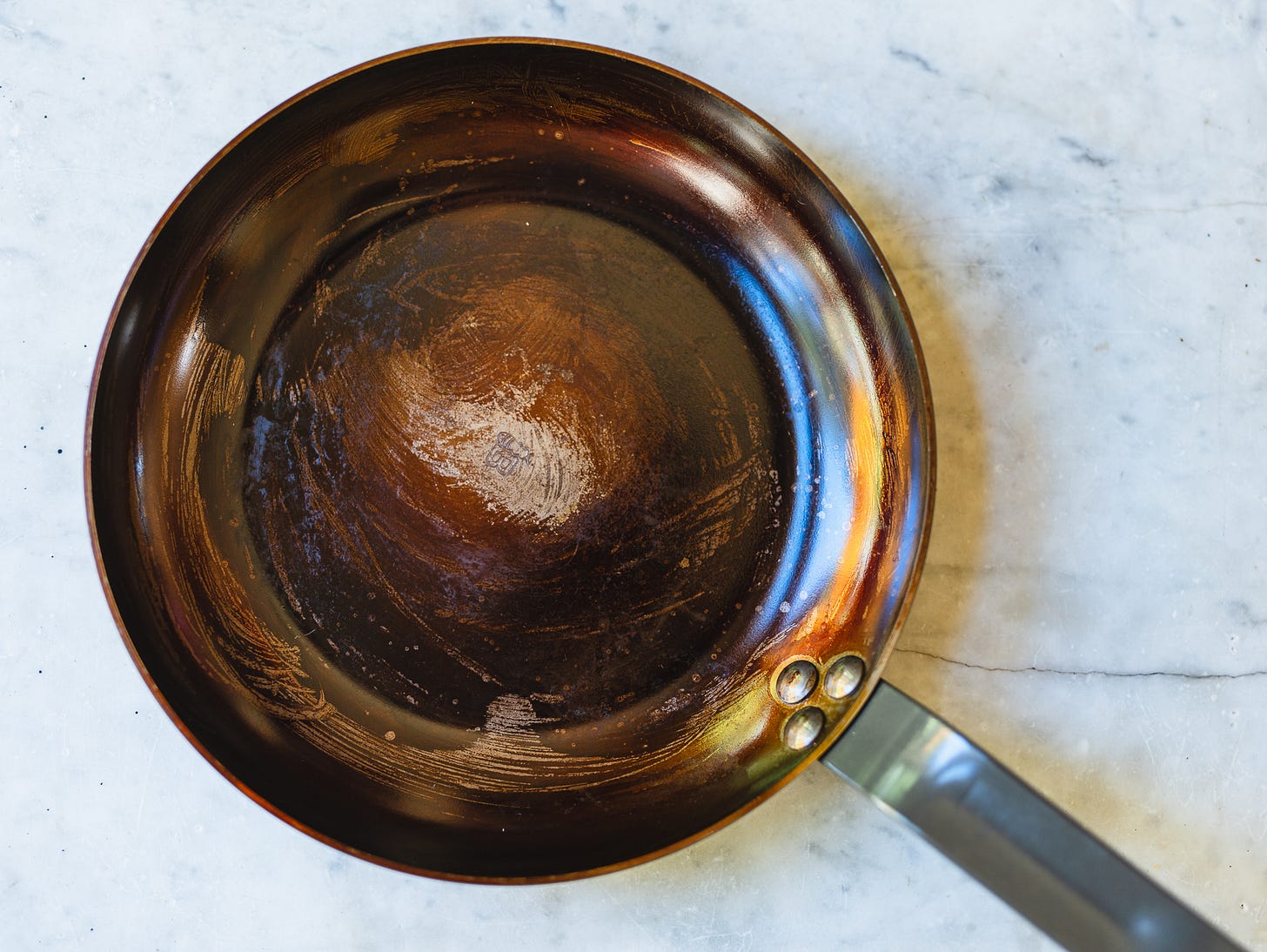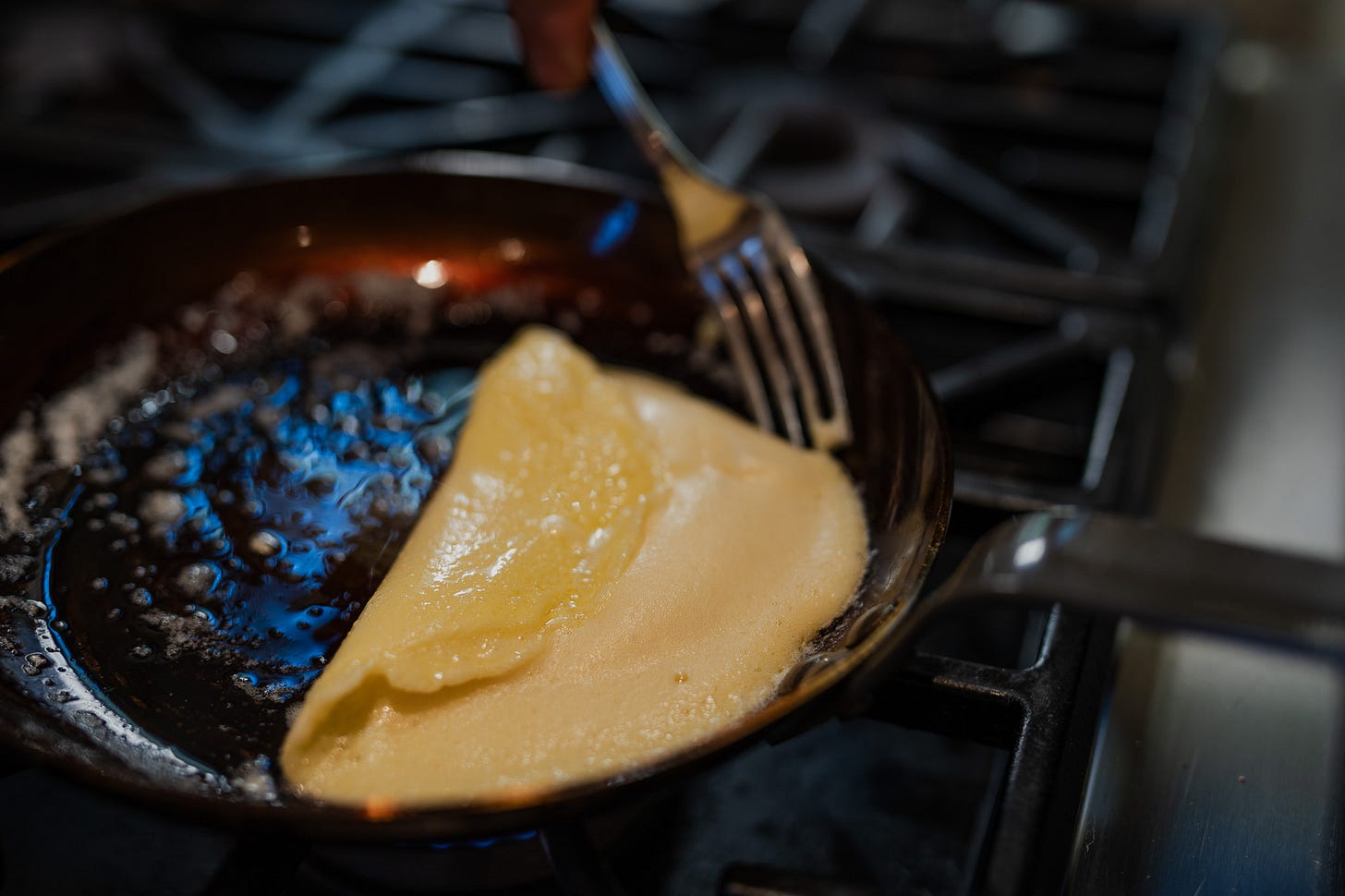I’ll never forget the day I “invented” Hollandaise sauce…Not one to suffer tutelage, I taught myself to cook. Studying the basics would likely have left me with fewer lapses in my knowledge and skills, making me a more well-rounded cook in a shorter amount of time. I did have mentors along the way, but I preferred to pursue what interested me, letting my appetite spur the learning.
Seduced by my first delicious taste in a San Francisco fish restaurant of house-made sauce tartare, a thinned-down mayonnaise spiked with lemon, capers, and chives and draped alongside a thick tranche of grilled swordfish, I was determined to repeat this delicious pairing. I consulted the Larousse Gastronomique, my culinary lexicon at the time, and assembled the ingredients for sauce tartare. My first attempts were disastrous. I learned that egg yolk and oil don’t naturally get along and that mayonnaise is not simply a mash-up but a skill demanding patience and careful attention. Once I mastered the alchemy of mounting egg yolk and oil to a silken emulsion, working it to a stiff mound, or slackening it with drops of water, I found that there was no end to the versatility of this sauce. Because mayonnaise is made up of only two simple ingredients, nearly indistinguishable when joined, it is principally a skill. Mayonnaise is the basis for the enhancements after which it is then named. Add herbs to make sauce verte; turn it in a mortar with garlic for aïoli; make it taste like the sea with tuna and anchovies (Tonnato); add capers, gherkins, mustard, and tarragon for Remoulade; whisk in reductions of shellfish, citrus zest, catsup, and piccalilli (Thousand Island); or just keep it plain with salt and a trace of vinegar. There is no end to what mayonnaise can transport.
Around the same time, I was also experimenting with the use of clarified butter for high-temperature cooking. Staring into the limpid butterfat floating on top of the drowned solids beneath, I had a bright idea. Why not use it to make mayonnaise instead of oil? Without cooling the butter, I drizzled it into egg yolks, watched it pull together and thicken and patted myself on the back for my invention of “butter mayonnaise.” Only later did I learn that what resulted— Sauce Hollandaise—is one of the five “Mother” sauces of French cuisine.
More recently, I reminded myself of what is behind my current morning ritual. Having grown tired of scrambled, fried, and poached eggs, and never really hungry until noon, I came up with a no-fuss way of cooking a single egg to suit my time and limited morning appetite. It consists of one egg, seasoned with salt only. Of course, yolks and whites will never achieve the loft of beaten whites alone. However, vigorous whisking of the two results in a foamy blend that has the weight of heavy cream. It makes a big difference if this mixture is cooked before it separates or deflates.
The resulting egg takes on the character of a flat souffle and achieves a soft, pillow-like texture. I am not a fan of browned eggs. Browning causes eggs to toughen and overcook, losing their inherent tenderness. Cooking a single egg is challenging for the fact that it offers little buffer against the heat of the pan. As such, temperature must be calibrated. Starting out, I either touch the pan with the palm of my hand to get a sense of the heat or I use a drop of water as an indicator. It should sizzle softly and then slowly vaporize. At this point, I add a tablespoon or so of butter and let it ride on its own melting across the surface of the pan. Meanwhile, I whisk the egg vigorously for about 30 seconds and pour it immediately into the top surface of the pan, at the same time tilting it such that the egg runs without delay to the opposite side, coating the entire surface along the way.
Important in making an omelette is the right pan and knowing how to use it. My pan of choice is a 9-½ inch seasoned carbon steel pan with shallow, curving sides. The pan is pretty and has a comfortable heft without weightiness; it is even and responsive.
Once the egg has covered the bottom of the pan, it is important to keep the flame low. Just as soon its edges firm up and while it is still soft in the middle, using the edge of a fork (with the pan handle toward me) I fold it over itself a few times from the far side of the pan toward the handle. Then I make the last closing fold onto the center with the open layer and move the pan off the heat.
With a backhand grip (think tennis), you slide the egg onto a toasted and buttered sweet baguette or other light, open-crumbed bread (it’s good to time the toasting so the bread is warm and ready) and drag a room-temperature knob of butter over the surface. I waste no time eating it, most often standing up. All told it takes about 30 seconds to cook an egg like this to perfection. Otherwise, a lapse in attention or timing spoils its delicacy.
I hadn’t made a true French omelette in years. My slender one-egg package was a reminder of that classic dish usually made with three eggs and with some necessary variations. It is easiest to describe what a French omelette is not–It is not the stuffed animal that is the American omelet served up in diners and “continental breakfast” rooms. Nor does it resemble the Italian frittata, the French omelette’s raucous cousin, an open-faced mixture of beaten eggs put to the service of binding any number of inclusions—cheese, vegetables, herbs, potatoes, meat or even pasta. Considered an ideal vehicle for using up leftovers, a frittata is most often improvised and the eggs themselves play second fiddle to these impromptu additions. A frittata is cooked in a pan, browned on the bottom (frittata comes from “friggere,”to fry), and because of its girth, finished in the oven.
Japanese Tamagoyaki is perhaps the closest cousin to the French omelette and is the most time-consuming and complex of cooked egg dishes. It is made in a rectangular steel pan by rolling a minimum of 5 thin layers of beaten egg, cooked successively until just set. Eggs are poured in one layer at a time, folded successively to the back edge of the pan, and then rolled, layer upon layer, and compressed in a sushi mat to create a uniform log. It is then cut into thick slices, the cross sections of which resemble mille-feuille. Tamagoyaki is a sweet omelet that comes from added sugar or sweet rice wine (mirin) and is served as a breakfast food, as a side in bento boxes, as a snack, or as a sushi topping. The process of making it requires great skill on the part of the chef to extend the beaten eggs into even, paper-thin, soft-cooked layers and to manage the feat of rolling and folding with the help of chopsticks alone. Kitchen lore has it that a French omelette tests everything that needs to be known about a cook in a matter of minutes—the choice of tools, the mis en place, sense of economy, heat management, timing, presentation, finesse. Likewise, sushi chefs are judged not only by their sashimi game but on the caliber of their tamagoyaki.
What I remember from eating an omelette in Paris is its sleek, surface, pale straw color, and cigar shape, a thin envelope tenuously holding a slightly wet scramble. There wasn’t anything to mask its pure, rich egginess, evidence of the quality of the eggs and the best sweet butter. Such is the omelette’s aspiration and its triumph.
Realizing a perfect omelette requires rapt attention. Such an omelette has everything to teach about noticing the details that make all the difference. Like Mayonnaise and Hollandaise, a French omelette is “above all, a technique”; three ingredients—eggs, butter and salt—the rest happens in the pan. Failure in the case of mayonnaise is a “broken” sauce, the dissociation of egg yolk and oil that occurs when oil is added in haste. Likewise, if butter in Hollandaise is added to egg yolks with a heavy hand or the mixture overheats, the sauce falls apart or curdles irretrievably. While it is possible to resuscitate a mayonnaise or a Hollandaise sauce, an omelette that has been overcooked through a lapse in attention cannot be recovered.
Great cooking is as full of intentionality as it is inspired by the fortuitous moment. My accidental “butter mayonnaise,” the French omelette I had forgotten and found myself instinctively adapting to a suitable version, might begin to explain how traditional dishes come about and how their variations evolve. Thoughts about what to do in the kitchen bubble up from reminiscence, from previous practice, from sight or scent, from distant travel to foreign tables or close at home in the kitchen garden. Thoughts begin to accrue and solidify through trial and error. Pondering the nature of an ingredient can unlock its potential and spur innovation. Great cooking is about execution but also about discovery. The best cooks learn to improvise, stay open to the unexpected, and know that repetition may prove to be ultimately dulling. You can taste the difference. Even dishes that are enshrined in tradition and reduced to technique can be enlivened by greeting the process anew. It is perhaps no accident that an egg is emblematic of Spring, creation, rebirth, and new beginnings. A single egg can hatch a family lineage in the hands of cooks and of the cultures that place their mark.










Beautiful writing. Informative and inspiring. I’m with Caroline--you two are pretty darn good eggs.
You're both good eggs.